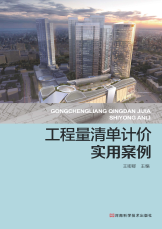
主要责任者: 王卿卿
责任方式: 主编
出版者: 河南科学技术出版社
出版地: 郑州
字数: 417 千字
页码: 1-228
中图分类号: TU723.3
语种:中
定价:58.00
出版时间:2014-04
丛书多卷书否:否
书目简介:本册工具书共收录74条词条。
| 词条 | 工程量清单计价实用案例 |
| 类别 | 中文百科知识 |
| 释义 |  主要责任者: 王卿卿 责任方式: 主编 出版者: 河南科学技术出版社 出版地: 郑州 字数: 417 千字 页码: 1-228 中图分类号: TU723.3 语种:中 定价:58.00 出版时间:2014-04 丛书多卷书否:否 书目简介:本册工具书共收录74条词条。 |
| 随便看 |
开放百科全书收录579518条英语、德语、日语等多语种百科知识,基本涵盖了大多数领域的百科知识,是一部内容自由、开放的电子版国际百科全书。